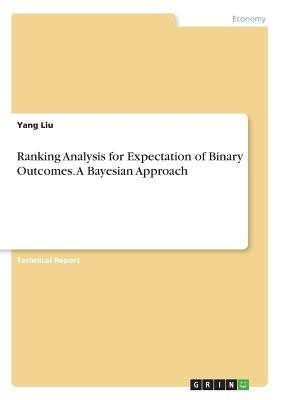
- We will send in 10–14 business days.
- Author: Yang Liu
- Publisher: GRIN Verlag
- ISBN-10: 3668458065
- ISBN-13: 9783668458062
- Format: 14.8 x 21 x 0.2 cm, minkšti viršeliai
- Language: English
- SAVE -10% with code: EXTRA
Ranking Analysis for Expectation of Binary Outcomes. A Bayesian Approach (e-book) (used book) | bookbook.eu
Reviews
Description
Technical Report from the year 2017 in the subject Economics - Statistics and Methods, language: English, abstract: The estimation and grading of customer Probability of Default (PD) using a firm-wide master scale for internal portfolios is a well established procedure in many financial institutions. However, there are often discussions within the institutions about the comparison between the grade PDs, the portfolio average PD calculated across grades and the observed Default Rate (DR). The Bayesian estimator for the grade PD based on different prior distribution assumption is often referred to as an alternative over the simple default rate. In this paper, we apply and compare the approaches to derive the posterior distribution of grade PDs that is closely linked to the portfolio performance assumptions made according to the Master Scale. We then detail the numerical analysis of both informed and uninformed Bayesian estimators for the Grade PDs with simulated single and multi-period data sets. We compare the results in term of prior and posterior Density-in-Range (DiR) and Direction-of-Movement (DoM) for each Grade. With data analysis and preference of criteria, the approach and metrics can be used for both model development and validation, or other risk-awareness reporting and information update exercises to help understand the difference between expectation and observed data. More importantly, this approach provides a methodology to quantify such differences according to knowledge and understanding of the observer, which was not possible for simple approaches such as direct numerical comparison of Master Scale defined PD and the simple rate.
EXTRA 10 % discount with code: EXTRA
The promotion ends in 21d.20:57:37
The discount code is valid when purchasing from 10 €. Discounts do not stack.
- Author: Yang Liu
- Publisher: GRIN Verlag
- ISBN-10: 3668458065
- ISBN-13: 9783668458062
- Format: 14.8 x 21 x 0.2 cm, minkšti viršeliai
- Language: English English
Technical Report from the year 2017 in the subject Economics - Statistics and Methods, language: English, abstract: The estimation and grading of customer Probability of Default (PD) using a firm-wide master scale for internal portfolios is a well established procedure in many financial institutions. However, there are often discussions within the institutions about the comparison between the grade PDs, the portfolio average PD calculated across grades and the observed Default Rate (DR). The Bayesian estimator for the grade PD based on different prior distribution assumption is often referred to as an alternative over the simple default rate. In this paper, we apply and compare the approaches to derive the posterior distribution of grade PDs that is closely linked to the portfolio performance assumptions made according to the Master Scale. We then detail the numerical analysis of both informed and uninformed Bayesian estimators for the Grade PDs with simulated single and multi-period data sets. We compare the results in term of prior and posterior Density-in-Range (DiR) and Direction-of-Movement (DoM) for each Grade. With data analysis and preference of criteria, the approach and metrics can be used for both model development and validation, or other risk-awareness reporting and information update exercises to help understand the difference between expectation and observed data. More importantly, this approach provides a methodology to quantify such differences according to knowledge and understanding of the observer, which was not possible for simple approaches such as direct numerical comparison of Master Scale defined PD and the simple rate.


Reviews